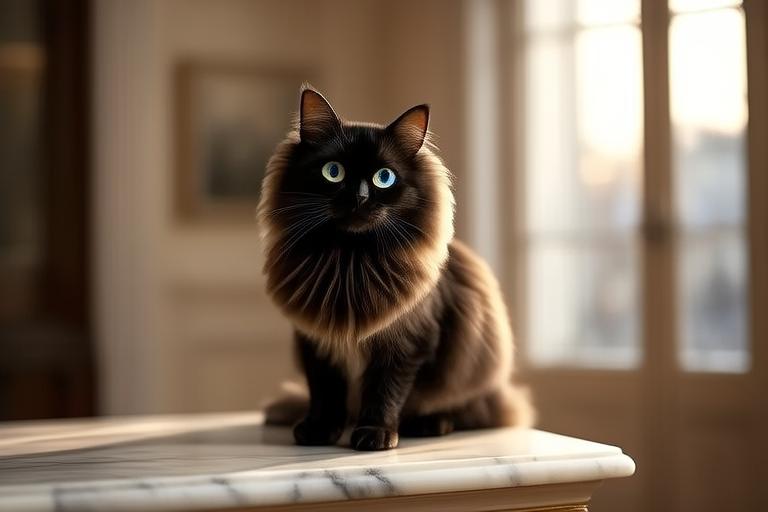Turkish Angora Cats: A Blend of Beauty and Intelligence Unmatched
In the realm of feline elegance and charm, few breeds can rival the Turkish Angora. With a history that spans centuries and a reputation for being both intelligent and graceful, these cats have captured the hearts of cat lovers around the world. This article delves into the rich history, unique physical attributes, and delightful personalities of the Turkish Angora, providing a comprehensive guide for those considering this breed or simply admiring its splendor.
Historical Background and Origin
The Turkish Angora originates from the Ankara region in central Turkey, where it has been cherished for over 400 years. Historical records suggest that these cats were kept by nobility and even sultans during the Ottoman Empire. The breed’s name pays homage to the city of Ankara (formerly known as Angora), which is also renowned for its production of angora wool. Turkish Angoras are believed to be descendants of the wild Asian steppe cat, and they share ancestry with other ancient breeds like the Persian and the Egyptian Mau. Their presence in Turkey dates back to the 16th century, and they were introduced to Europe in the 17th century, gaining popularity among European royalty. Despite their long history, the Turkish Angora remained relatively rare until the 20th century when dedicated breeding programs helped preserve and promote the breed.
Distinctive Physical Features
One of the most striking aspects of the Turkish Angora is its elegant physique. These cats are medium-sized with a slender, muscular build that gives them a graceful and lithe appearance. Their legs are long and slender, complementing their elongated body, while their tails are thick and bushy. The head is wedge-shaped, with large, pointed ears that give them an alert and attentive look. Their eyes are almond-shaped and come in a variety of colors, including blue, green, gold, and even heterochromia, where each eye is a different color. This eye diversity is one of the breed’s most distinctive features, adding to their allure.
Perhaps the most celebrated aspect of the Turkish Angora is its luxurious coat. The breed comes in a wide range of colors and patterns, but it is particularly prized for its silky, semi-longhaired coat that is soft to the touch. The coat is typically white, but various colors and markings can occur, including tabby, black, and tortoiseshell. One of the most fascinating characteristics of the Turkish Angora’s coat is its texture; it is fine and silky, often described as having a “downy” feel. This coat requires minimal grooming, making it ideal for owners who want a beautiful cat without the hassle of extensive grooming.
Intelligence, Adaptability, and Personality
Besides their stunning looks, Turkish Angoras are highly intelligent and curious creatures. They are quick learners and enjoy interactive play, often engaging in games that challenge their problem-solving skills. Their adaptability makes them suitable for a variety of living environments, whether it be a bustling household or a serene apartment. These cats are known for their playful nature, often displaying a kitten-like exuberance well into adulthood. However, their playfulness is balanced with a gentle and affectionate demeanor, making them excellent companions for families and individuals alike.
Turkish Angoras form strong bonds with their human companions and are known to be very loyal. They are social animals that thrive on attention and interaction, often following their owners around the house, seeking out affection and engagement. While they are generally friendly towards strangers, they tend to form close attachments with specific family members, often becoming devoted to one person. Their intelligence and sociable nature make them adept at learning tricks and commands, further enhancing their appeal as pets.
Health, Common Traits, and Special Care Requirements
Despite their delicate appearance, Turkish Angoras are generally healthy and robust cats. Like all breeds, they are prone to certain genetic conditions, such as hypertrophic cardiomyopathy (HCM), a heart disease that can affect some purebred cats. Regular veterinary check-ups and early detection are crucial for managing this condition effectively. Another common issue in Turkish Angoras is patellar luxation, a joint disorder that can cause discomfort and mobility issues. Routine monitoring and preventive care can help mitigate these risks.
Special care requirements for Turkish Angoras primarily revolve around their grooming needs. Although their coats are low-maintenance, regular brushing helps prevent matting and keeps their fur in top condition. Bathing is usually unnecessary unless the cat gets particularly dirty, but occasional brushing can help remove loose hair and reduce shedding. It is important to note that Turkish Angoras are sensitive to anesthesia, so owners should inform veterinarians about this before any surgical procedures.
Why Turkish Angoras Stand Out
Turkish Angoras stand out among cat breeds for their unique blend of beauty, intelligence, and personality. Their elegant appearance, combined with their playful and affectionate nature, makes them an ideal choice for those seeking a companion that is both visually stunning and emotionally engaging. Their adaptability to various living situations and their ability to form deep bonds with their owners make them excellent pets for families and individuals alike. Whether you’re drawn to their striking appearance or captivated by their charming personalities, Turkish Angoras offer a truly unmatched experience for cat enthusiasts and potential owners.
For those looking for a cat that combines grace, intelligence, and companionship, the Turkish Angora is a breed worth considering. With their rich history, distinctive features, and endearing personalities, these cats continue to enchant and delight owners worldwide. Whether you’re a seasoned cat lover or new to the world of feline companions, the Turkish Angora offers a unique and rewarding experience that will leave you charmed and fulfilled.
